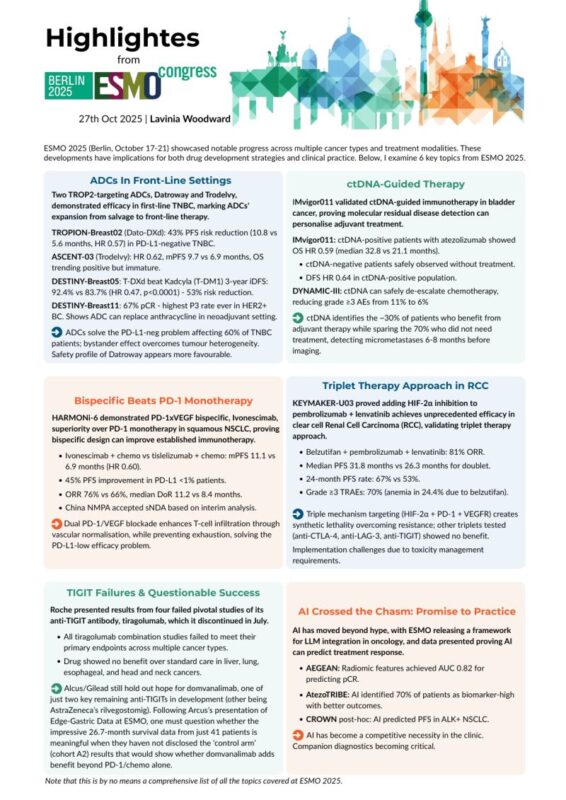Lavinia Woodward, Senior Product Development Producer at Beacon, shared a post on LinkedIn:
“ESMO 2025: Strategic Implications from Key Data Readouts
Data presented at ESMO25 revealed critical shifts in oncology development strategies. Biopharma strategic decision-makers, investors: here’s what matters
ADCs Reshape Front-Line Treatment Paradigms
Two TROP2 ADCs demonstrated meaningful efficacy in 1L TNBC:
- TROPION-Breast02 (Datroway): 43% PFS risk reduction, 5-month OS benefit.
- ASCENT-03 (Trodelvy): 38% PFS improvement, HR 0.62.
DESTINY trials position Enhertu for early HER2+ dominance with unprecedented pCR rates (67% vs 56%).
The question is no longer whether ADCs are effective; rather, will superior potency and selective targeting allow them to replace conventional chemotherapy in early treatment lines? Whether as monotherapies or combined with immunotherapy, ADCs are poised to reshape therapeutic standards across breast cancer subtypes. Realising this potential demands parallel advances in biomarker identification, patient selection, treatment sequencing, and toxicity management.
ctDNA-Guided Therapy Proves Its Worth
IMvigor011 validated MRD-guided immunotherapy with a 40% mortality reduction in ctDNA-positive bladder cancer patients, while ctDNA-negative patients avoided unnecessary treatment. DYNAMIC-III demonstrated the feasibility of de-escalation based on molecular residual disease status.
Triplet Therapy in RCC: Mechanism Matters
KEYMAKER-U03 revealed that belzutifan (HIF-2α inhibitor) added to pembrolizumab/lenvatinib improved outcomes (81% ORR, PFS HR 0.45). Other combinations failed to show benefit, highlighting that successful triplets require complementary mechanisms, not simply additional agents.
Bispecifics Rise as TIGIT Falls
Multiple SKYSCRAPER trials confirmed TIGIT’s failure to deliver clinical benefit. Conversely, ivonescimab (PD-1/VEGF bispecific) demonstrated superiority over PD-1 monotherapy in HARMONi-6 (PFS 11.1 vs 6.9 months).
The pivot point: Next-generation immunotherapy lies in engineered bispecifics, not sequential checkpoint combinations.
AI Moves from Experimental to Essential
- AEGEAN: Radiomic features predicted pathological complete response (AUC 0.82).
- AtezoTRIBE: AI-identified biomarkers doubled survival benefit in selected patients.
- CROWN: Post-hoc AI analysis predicted PFS in ALK+ NSCLC.
These are not pilot studies; AI is not just hype; AI is becoming a need-to-have in clinical oncology.
Data presented at ESMO this year suggests we are witnessing a convergence of precision diagnostics, novel drug modalities, and AI-driven decision-making that will define the next era of oncology development.
What were your key takeaways from ESMO 2025? How do you see these findings, particularly around front-line use of ADCs, and ctDNA-guided therapy, shaping the oncology landscape over the next 2-3 years?”

More posts featuring Lavinia Woodward on OncoDaily.
